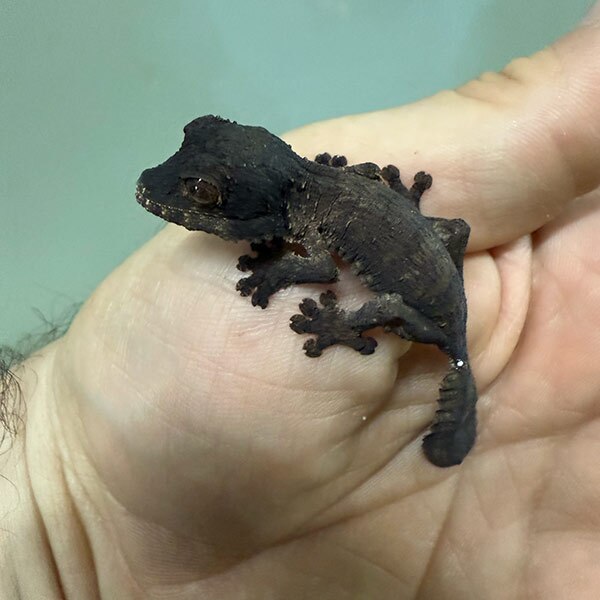Welcome to our comprehensive guide on Henkel’s Leaf-Tailed Gecko, scientifically known as Uroplatus henkeli—one of the most captivating species in the Uroplatus genus and undoubtedly our favorite here at Nealon Reptiles! These incredible geckos, native to the lush forests of Madagascar, are known for their impressive size, striking camouflage, and calm demeanor. With their ability to blend perfectly into tree bark and distinctive appearance, Uroplatus henkeli is a fascinating species for both beginner and experienced reptile enthusiasts.
This guide will teach you everything you need to know about keeping and breeding Uroplatus henkeli. From creating the perfect enclosure to ensuring their health and well-being with proper husbandry techniques, we’ll provide all the expert advice you need to help your Henkel’s Leaf-Tailed Gecko thrive. We’re excited to share our passion for this incredible species and help you know why it’s our favorite!

Being one of the larger species of Uroplatus, Henkel’s Leaf-tailed Gecko needs a larger enclosure. Here at our breeding facility, we keep our adults in Enclosures 4 feet wide, 4 feet tall, and 2 feet deep. This gives them more than enough room to move around and act naturally. While some people keep their henkeli in 2 feet wide enclosures, the double width is certainly appreciated.
Throughout the Enclosure, we’ll place multiple vertically orientated branches to mimic tree trunks. We’ll then place a few smaller branches, giving some horizontal access. We often use larger plants such as Elephant Ear plants, Birds of Paradise, and Snake Plants. For the substrate, we use aquarium filter foam that is 2 inches thick. In our experience, aquarium foam works great, especially when caring for many Geckos.
Add yourself a lay bin if you have adult females in the enclosure, and you’ll be all set!
Feeding Uroplatus henkeli
Feeding Uroplatus henkeli is a pretty simple affair. They’re insectivores, meaning they eat insects for all of their diet.
We feed our henkeli geckos a combination of Crickets, Dubia Roaches, and Red Runner Roaches. Of course, you want to ensure that all of the insects you feed them are of an appropriate size. In our experience, the advice of ‘don’t feed a reptile an insect larger than the space between its eyes’ is not great, especially for experienced breeders. These geckos will take down larger insects than you might think and without issue.
Our Henkel’s Leaf-tailed Geckos are fed three times weekly most of the year. During the warm seasons, we want to ensure they get enough food to grow and replace their energy from breeding. While both sexes need more calories for breeding season, this is especially important for egg-producing females.
During the cool, dry season, we dramatically cut back on feedings. In their native habitat, the number of insects dwindles during the cool season. This means that if we are to mimic their native habitat and environmental conditions for breeding, they should be fed less. We will cut back to feeding twice per week. In addition, multiple times throughout the cool season, we’ll skip feeding them for 7-10 days each time. We also cut back on the number of insects being fed, aiming for 50% of what we’d normally feed them. Not only are there no ill effects to doing this, but we feel this is vital to ensuring that the Henkeli know it is time to take it easy and rest up for the next breeding season.
Newly hatched Henkel’s Geckos are fed 4-5 times per week, as much as they will eat. Once they reach about 6 months, they’ll enter their adult enclosures and be fed on the same schedule as the adults.
Supplementation for Uroplatus henkeli
Supplementing the feeder insects you’re giving your henkeli will help ensure they receive all the vitamins and minerals they need to be healthy. We supplement fairly lightly, using Arcadia supplements. For most of the feedings, we’ll use Arcadia EarthPro-A. Twice per month, we’ll see the Arcadia supplement with Magnesium.
Breeding Henkel’s Leaf-tailed Gecko
So, you’re interested in breeding Uroplatus henkeli? Great! Over the last few years, more people have been interested in breeding them. However, they are still relatively uncommonly bred in captivity, aside from a few dedicated facilities like ours.
Henkel’s Leaf-tailed Gecko comes from an area of Madagascar that doesn’t see seasonal fluctuations as dramatic as other Uroplatus habitats. While providing seasonal fluctuations in heating, lighting, and humidity is still important, it isn’t quite as important as it is with other species of Uroplatus.
Incubating Eggs
Whenever we find eggs, we carefully transfer those eggs into an incubation container. We use 16-ounce deli cups with 2 small holes poked in the lid. We fill the container about 1/3 of the way with Pangea Hatching Material. Of course, we hydrate this according to the directions. We then scoop out a small divet large enough for a 1-ounce gecko food cup to sit in. We fill the gecko food cup about 1/2 way with dry Hatching Material, making sure to leave a small depression for the egg to sit in. After placing the egg, we use a spoon to place more incubation material around the egg, but not covering it, to ensure it doesn’t roll or move during the incubation process.
We incubate eggs for Uroplatus henkeli in an incubator. While many breeders choose to leave their eggs at room temperature (which is usually fine), we want to provide more exacting conditions for the incubation of these Leaf-tail eggs. We pride ourselves on constantly collecting data about our animals, and the incubator allows us to have a consistent environment so that our data is based on a controlled environment.
Even though our eggs are incubated in an incubator, we still lower the temperature at night. During the day, our eggs are kept at 73 degrees. At night, the incubator drops to 68 degrees. We feel that this drop in temperature at night is important for hatching healthy and resilient offspring.
The humidity inside the incubator is kept at 90% by placing a plastic shoe box with water in it on the bottom shelf of the incubator. Ensure that your incubation containers don’t accumulate water on the inside, especially on the bottom of the lid. While a small amount of condensation is okay, you don’t want water droplets forming inside the incubation container. This can lead to egg rot and loss. Having two 1/4 inch holes in the lid of the container will allow air exchange, which removes gases from the container and allows air movement to wick away excess moisture.
